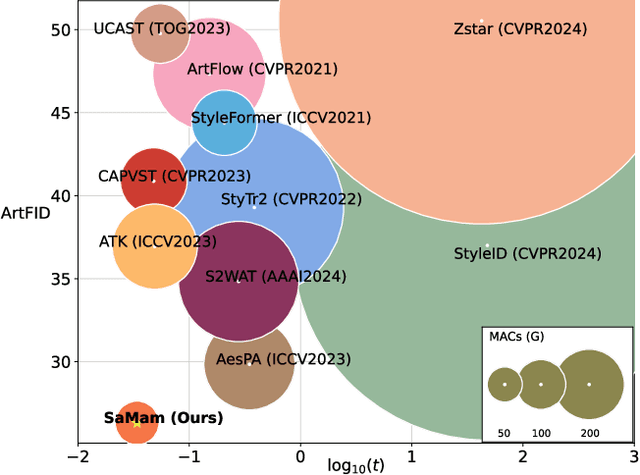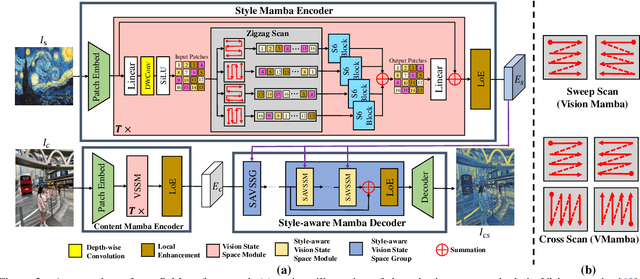Yulan Guo
CDP: Towards Robust Autoregressive Visuomotor Policy Learning via Causal Diffusion
Jun 17, 2025Abstract:Diffusion Policy (DP) enables robots to learn complex behaviors by imitating expert demonstrations through action diffusion. However, in practical applications, hardware limitations often degrade data quality, while real-time constraints restrict model inference to instantaneous state and scene observations. These limitations seriously reduce the efficacy of learning from expert demonstrations, resulting in failures in object localization, grasp planning, and long-horizon task execution. To address these challenges, we propose Causal Diffusion Policy (CDP), a novel transformer-based diffusion model that enhances action prediction by conditioning on historical action sequences, thereby enabling more coherent and context-aware visuomotor policy learning. To further mitigate the computational cost associated with autoregressive inference, a caching mechanism is also introduced to store attention key-value pairs from previous timesteps, substantially reducing redundant computations during execution. Extensive experiments in both simulated and real-world environments, spanning diverse 2D and 3D manipulation tasks, demonstrate that CDP uniquely leverages historical action sequences to achieve significantly higher accuracy than existing methods. Moreover, even when faced with degraded input observation quality, CDP maintains remarkable precision by reasoning through temporal continuity, which highlights its practical robustness for robotic control under realistic, imperfect conditions.
Probing Deep into Temporal Profile Makes the Infrared Small Target Detector Much Better
Jun 15, 2025Abstract:Infrared small target (IRST) detection is challenging in simultaneously achieving precise, universal, robust and efficient performance due to extremely dim targets and strong interference. Current learning-based methods attempt to leverage ``more" information from both the spatial and the short-term temporal domains, but suffer from unreliable performance under complex conditions while incurring computational redundancy. In this paper, we explore the ``more essential" information from a more crucial domain for the detection. Through theoretical analysis, we reveal that the global temporal saliency and correlation information in the temporal profile demonstrate significant superiority in distinguishing target signals from other signals. To investigate whether such superiority is preferentially leveraged by well-trained networks, we built the first prediction attribution tool in this field and verified the importance of the temporal profile information. Inspired by the above conclusions, we remodel the IRST detection task as a one-dimensional signal anomaly detection task, and propose an efficient deep temporal probe network (DeepPro) that only performs calculations in the time dimension for IRST detection. We conducted extensive experiments to fully validate the effectiveness of our method. The experimental results are exciting, as our DeepPro outperforms existing state-of-the-art IRST detection methods on widely-used benchmarks with extremely high efficiency, and achieves a significant improvement on dim targets and in complex scenarios. We provide a new modeling domain, a new insight, a new method, and a new performance, which can promote the development of IRST detection. Codes are available at https://github.com/TinaLRJ/DeepPro.
MonoMobility: Zero-Shot 3D Mobility Analysis from Monocular Videos
May 17, 2025Abstract:Accurately analyzing the motion parts and their motion attributes in dynamic environments is crucial for advancing key areas such as embodied intelligence. Addressing the limitations of existing methods that rely on dense multi-view images or detailed part-level annotations, we propose an innovative framework that can analyze 3D mobility from monocular videos in a zero-shot manner. This framework can precisely parse motion parts and motion attributes only using a monocular video, completely eliminating the need for annotated training data. Specifically, our method first constructs the scene geometry and roughly analyzes the motion parts and their initial motion attributes combining depth estimation, optical flow analysis and point cloud registration method, then employs 2D Gaussian splatting for scene representation. Building on this, we introduce an end-to-end dynamic scene optimization algorithm specifically designed for articulated objects, refining the initial analysis results to ensure the system can handle 'rotation', 'translation', and even complex movements ('rotation+translation'), demonstrating high flexibility and versatility. To validate the robustness and wide applicability of our method, we created a comprehensive dataset comprising both simulated and real-world scenarios. Experimental results show that our framework can effectively analyze articulated object motions in an annotation-free manner, showcasing its significant potential in future embodied intelligence applications.
A Unified Hierarchical Framework for Fine-grained Cross-view Geo-localization over Large-scale Scenarios
May 12, 2025Abstract:Cross-view geo-localization is a promising solution for large-scale localization problems, requiring the sequential execution of retrieval and metric localization tasks to achieve fine-grained predictions. However, existing methods typically focus on designing standalone models for these two tasks, resulting in inefficient collaboration and increased training overhead. In this paper, we propose UnifyGeo, a novel unified hierarchical geo-localization framework that integrates retrieval and metric localization tasks into a single network. Specifically, we first employ a unified learning strategy with shared parameters to jointly learn multi-granularity representation, facilitating mutual reinforcement between these two tasks. Subsequently, we design a re-ranking mechanism guided by a dedicated loss function, which enhances geo-localization performance by improving both retrieval accuracy and metric localization references. Extensive experiments demonstrate that UnifyGeo significantly outperforms the state-of-the-arts in both task-isolated and task-associated settings. Remarkably, on the challenging VIGOR benchmark, which supports fine-grained localization evaluation, the 1-meter-level localization recall rate improves from 1.53\% to 39.64\% and from 0.43\% to 25.58\% under same-area and cross-area evaluations, respectively. Code will be made publicly available.
Pack-PTQ: Advancing Post-training Quantization of Neural Networks by Pack-wise Reconstruction
May 01, 2025Abstract:Post-training quantization (PTQ) has evolved as a prominent solution for compressing complex models, which advocates a small calibration dataset and avoids end-to-end retraining. However, most existing PTQ methods employ block-wise reconstruction, which neglects cross-block dependency and exhibits a notable accuracy drop in low-bit cases. To address these limitations, this paper presents a novel PTQ method, dubbed Pack-PTQ. First, we design a Hessian-guided adaptive packing mechanism to partition blocks into non-overlapping packs, which serve as the base unit for reconstruction, thereby preserving the cross-block dependency and enabling accurate quantization parameters estimation. Second, based on the pack configuration, we propose a mixed-precision quantization approach to assign varied bit-widths to packs according to their distinct sensitivities, thereby further enhancing performance. Extensive experiments on 2D image and 3D point cloud classification tasks, using various network architectures, demonstrate the superiority of our method over the state-of-the-art PTQ methods.
DropoutGS: Dropping Out Gaussians for Better Sparse-view Rendering
Apr 13, 2025Abstract:Although 3D Gaussian Splatting (3DGS) has demonstrated promising results in novel view synthesis, its performance degrades dramatically with sparse inputs and generates undesirable artifacts. As the number of training views decreases, the novel view synthesis task degrades to a highly under-determined problem such that existing methods suffer from the notorious overfitting issue. Interestingly, we observe that models with fewer Gaussian primitives exhibit less overfitting under sparse inputs. Inspired by this observation, we propose a Random Dropout Regularization (RDR) to exploit the advantages of low-complexity models to alleviate overfitting. In addition, to remedy the lack of high-frequency details for these models, an Edge-guided Splitting Strategy (ESS) is developed. With these two techniques, our method (termed DropoutGS) provides a simple yet effective plug-in approach to improve the generalization performance of existing 3DGS methods. Extensive experiments show that our DropoutGS produces state-of-the-art performance under sparse views on benchmark datasets including Blender, LLFF, and DTU. The project page is at: https://xuyx55.github.io/DropoutGS/.
Pluggable Style Representation Learning for Multi-Style Transfer
Mar 26, 2025Abstract:Due to the high diversity of image styles, the scalability to various styles plays a critical role in real-world applications. To accommodate a large amount of styles, previous multi-style transfer approaches rely on enlarging the model size while arbitrary-style transfer methods utilize heavy backbones. However, the additional computational cost introduced by more model parameters hinders these methods to be deployed on resource-limited devices. To address this challenge, in this paper, we develop a style transfer framework by decoupling the style modeling and transferring. Specifically, for style modeling, we propose a style representation learning scheme to encode the style information into a compact representation. Then, for style transferring, we develop a style-aware multi-style transfer network (SaMST) to adapt to diverse styles using pluggable style representations. In this way, our framework is able to accommodate diverse image styles in the learned style representations without introducing additional overhead during inference, thereby maintaining efficiency. Experiments show that our style representation can extract accurate style information. Moreover, qualitative and quantitative results demonstrate that our method achieves state-of-the-art performance in terms of both accuracy and efficiency. The codes are available in https://github.com/The-Learning-And-Vision-Atelier-LAVA/SaMST.
SaMam: Style-aware State Space Model for Arbitrary Image Style Transfer
Mar 20, 2025



Abstract:Global effective receptive field plays a crucial role for image style transfer (ST) to obtain high-quality stylized results. However, existing ST backbones (e.g., CNNs and Transformers) suffer huge computational complexity to achieve global receptive fields. Recently, the State Space Model (SSM), especially the improved variant Mamba, has shown great potential for long-range dependency modeling with linear complexity, which offers a approach to resolve the above dilemma. In this paper, we develop a Mamba-based style transfer framework, termed SaMam. Specifically, a mamba encoder is designed to efficiently extract content and style information. In addition, a style-aware mamba decoder is developed to flexibly adapt to various styles. Moreover, to address the problems of local pixel forgetting, channel redundancy and spatial discontinuity of existing SSMs, we introduce both local enhancement and zigzag scan. Qualitative and quantitative results demonstrate that our SaMam outperforms state-of-the-art methods in terms of both accuracy and efficiency.
OnlineAnySeg: Online Zero-Shot 3D Segmentation by Visual Foundation Model Guided 2D Mask Merging
Mar 03, 2025Abstract:Online 3D open-vocabulary segmentation of a progressively reconstructed scene is both a critical and challenging task for embodied applications. With the success of visual foundation models (VFMs) in the image domain, leveraging 2D priors to address 3D online segmentation has become a prominent research focus. Since segmentation results provided by 2D priors often require spatial consistency to be lifted into final 3D segmentation, an efficient method for identifying spatial overlap among 2D masks is essential - yet existing methods rarely achieve this in real time, mainly limiting its use to offline approaches. To address this, we propose an efficient method that lifts 2D masks generated by VFMs into a unified 3D instance using a hashing technique. By employing voxel hashing for efficient 3D scene querying, our approach reduces the time complexity of costly spatial overlap queries from $O(n^2)$ to $O(n)$. Accurate spatial associations further enable 3D merging of 2D masks through simple similarity-based filtering in a zero-shot manner, making our approach more robust to incomplete and noisy data. Evaluated on the ScanNet and SceneNN benchmarks, our approach achieves state-of-the-art performance in online, open-vocabulary 3D instance segmentation with leading efficiency.
AIQViT: Architecture-Informed Post-Training Quantization for Vision Transformers
Feb 07, 2025Abstract:Post-training quantization (PTQ) has emerged as a promising solution for reducing the storage and computational cost of vision transformers (ViTs). Recent advances primarily target at crafting quantizers to deal with peculiar activations characterized by ViTs. However, most existing methods underestimate the information loss incurred by weight quantization, resulting in significant performance deterioration, particularly in low-bit cases. Furthermore, a common practice in quantizing post-Softmax activations of ViTs is to employ logarithmic transformations, which unfortunately prioritize less informative values around zero. This approach introduces additional redundancies, ultimately leading to suboptimal quantization efficacy. To handle these, this paper proposes an innovative PTQ method tailored for ViTs, termed AIQViT (Architecture-Informed Post-training Quantization for ViTs). First, we design an architecture-informed low rank compensation mechanism, wherein learnable low-rank weights are introduced to compensate for the degradation caused by weight quantization. Second, we design a dynamic focusing quantizer to accommodate the unbalanced distribution of post-Softmax activations, which dynamically selects the most valuable interval for higher quantization resolution. Extensive experiments on five vision tasks, including image classification, object detection, instance segmentation, point cloud classification, and point cloud part segmentation, demonstrate the superiority of AIQViT over state-of-the-art PTQ methods.
 Add to Chrome
Add to Chrome Add to Firefox
Add to Firefox Add to Edge
Add to Edge